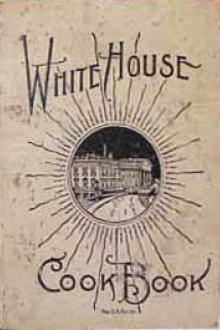The Whitehouse Cookbook (1887), Hugo Ziemann [world of reading .TXT] 📗

- Author: Hugo Ziemann
- Performer: -
Book online «The Whitehouse Cookbook (1887), Hugo Ziemann [world of reading .TXT] 📗». Author Hugo Ziemann
BAKED CALF'S HEAD.
Boil a calf's head (after having cleaned it) until tender, then split it in two, and keep the best half (bone it if you like); cut the meat from the other in uniform pieces, the size of an oyster; put bits of butter, the size of a nutmeg, all over the best half of the head; sprinkle pepper over it, and dredge on flour until it looks white, then set it on a trivet or muffin rings in a dripping-pan; put a cup of water into the pan, and set it in a hot oven; turn it that it may brown evenly; baste once or twice. Whilst this is doing, dip the prepared pieces of the head in wheat flour or batter, and fry in hot lard or beef drippings a delicate brown; season with pepper and salt and slices of lemon, if liked. When the roast is done put it on a hot dish, lay the fried pieces around it, and cover it with a tin cover; put the gravy from the dripping-pan into the pan in which the pieces were fried, with the slices of lemon, and a tablespoonful of browned flour, and, if necessary, a little hot water. Let it boil up once, and strain it into a gravy boat, and serve with the meat.
CALF'S HEAD CHEESE.
Boil a calf's head in water enough to cover it, until the meat leaves the bones; then take it with a skimmer into a wooden bowl or tray; take from it every particle of bone; chop it small; season with pepper and salt, a heaping tablespoonful of salt and a teaspoonful of pepper will be sufficient; if liked, add a tablespoonful of finely chopped sweet herbs; lay in a cloth in a colander, put the minced meat into it, then fold the cloth closely over it, lay a plate over, and on it a gentle weight. When cold it may be sliced thin for supper or sandwiches. Spread each slice with made mustard.
BRAIN CUTLETS.
Well wash the brains and soak them in cold water until white. Parboil them until tender in a small saucepan for about a quarter of an hour; then thoroughly drain them and place them on a board. Divide them into small pieces with a knife. Dip each piece into flour, and then roll them in egg and bread crumbs, and fry them in butter or well-clarified drippings. Serve very hot with gravy. Another way of doing brains is to prepare them as above, and then stew them gently in rich stock, like stewed sweetbreads. They are also nice plainly boiled and served with parsley and butter sauce.
CALFS HEAD BOILED.
Put the head into boiling water and let it remain about five minutes; take it out, hold it by the ear, and with the back of the knife scrape off the hair (should it not come off easily dip the head again in boiling water.) When perfectly clean take out the eyes, cut off the ears and remove the brain, which soak for an hour in warm water. Put the head to soak in hot water a few minutes to make it look white, and then have ready a stewpan, into which lay the head; cover it with cold water and bring it gradually to boil. Remove the scum and add a little salt, which increases it and causes it to rise to the top. Simmer it very gently from two and a half to three hours, or until the bones will slip out easily, and when nearly done, boil the brains fifteen or twenty minutes; skin and chop them (not too finely), add a tablespoonful of minced parsley which has been previously scalded; also a pinch of pepper, salt; then stir into this four tablespoonfuls of melted butter; set it on the back of the range to keep it hot. When the head is done, take it up and drain very dry. Score the top and rub it over with melted butter; dredge it with flour and set it in the oven to brown.
When you serve the head, have it accompanied with a gravy boat of melted butter and minced parsley.
CALF'S LIVER AND BACON.
Slice the liver a quarter of an inch thick; pour hot water over it and let it remain for a few minutes to clear it from blood; then dry it in a cloth. Take a pound of bacon, or as much as you require, and cut the same number of thin slices as you have of liver; fry the bacon to a nice crisp; take it out and keep it hot; then fry the liver in the same pan, having first seasoned it with pepper and salt and dredged in a little flour; lay it in the hot bacon fat and fry it a nice brown. Serve it with a slice of bacon on the top of each slice of liver.
If you wish a gravy with it, pour off most of the fat from the frying pan, put in about two ounces of butter, a tablespoonful of flour well rubbed in, add a cup of water, salt and pepper, give it one boil and serve in a gravy boat.
Another Way.—Cut the liver in nice thin slices, pour boiling water over it and let it stand about five minutes; then drain and put in a dripping-pan with three or four thin slices of salt pork or bacon; pepper and salt and put in the oven, letting it cook until thoroughly done, then serve with a cream or milk gravy poured over it.
Calf's liver and bacon are very good broiled after cutting each in thin slices. Season with butter, pepper and salt.
CROQUETTES OF SWEETBREADS.
Take four veal sweetbreads, soak them for an hour in cold salted water, first removing the pipes and membranes; then put them into boiling salted water with a tablespoonful of vinegar, and cook them twenty minutes, then drop them again into cold water to harden. Now remove them, chop them very fine, almost to a paste. Season with salt, pepper and a teaspoonful of grated onion; add the beaten yolks of three raw eggs, one tablespoonful of butter, half a cupful of cream, and sufficient fine cracker crumbs to make stiff enough to roll out into little balls or cork-shaped croquettes. Have ready a frying kettle half full of fat over the fire, a dish containing three smoothly beaten eggs, a large platter of cracker dust; wet the hands with cold water and make the mixture in shape; afterwards rolling them in the cracker dust, then into the beaten egg, and again in the cracker dust; smooth them on the outside and drop them carefully in the hot fat. When the croquettes are fried a nice golden brown, put them on a brown paper a moment to free them from grease. Serve hot with sliced lemon or parsley.
SWEETBREADS.
There are two in a calf, which are considered delicacies. Select the largest. The color should be clear and a shade darker than the fat. Before cooking in any manner let them lie for half an hour in tepid water; then throw into hot water to whiten and harden, after which draw off the outer casing, remove the little pipes, and cut into thin slices. They should always be thoroughly cooked.
FRIED SWEETBREADS.
After preparing them as above they are put into hot fat and butter, and fried the same as lamb chops, also broiled the same, first rolling them in egg and cracker crumbs.
BAKED SWEETBREADS.
Three sweetbreads, egg and bread crumbs, oiled butter, three slices of toast, brown gravy.
Choose large, white sweetbreads, put them into warm water to draw out the blood, and to improve their color; let them remain for rather more than one hour; then put them into boiling water, and allow them to simmer for about ten minutes which renders them firm. Take them up, drain them, brush over the egg, sprinkle with bread crumbs; dip them in egg again, and then into more bread crumbs. Drop on them a little oiled butter, and put the sweetbreads into a moderately heated oven, and let them bake for nearly three-quarters of an hour. Make three pieces of toast; place the sweetbreads on the toast, and pour round, but not over, them a good brown gravy.
FRICASSEED SWEETBREADS.
If they are uncooked, cut into thin slices, let them simmer in a rich gravy for three-quarters of an hour, add a well-beaten egg, two tablespoonfuls of cream and a tablespoonful of chopped parsley; stir all together for a few minutes and serve immediately.
ROAST MUTTON.
The pieces mostly used for roasting are the hind-quarter of the sheep, called the loin and leg, the fore-quarter, the shoulder, also the chine or saddle, which is the two loins together. Every part should be trimmed off that cannot be eaten; then wash well and dry with a clean cloth; lay it in your dripping-pan and put in a little water to baste it with at first; then afterward with its own gravy. Allow, in roasting, about twelve minutes to the pound; that is, if your fire is strong, which it should be. It should not be salted at first, as that tends to harden it, and draws out too much of the blood or juices; but salt soon after it begins to roast well. If there is danger of its browning too fast, cover it with a sheet of white paper. Baste it often, and about a quarter of an hour before you think it will be done dredge the meat very lightly with flour and baste it with butter. Skim the gravy well and thicken very slightly with brown flour. Serve with currant jelly or other tart sauce.
BONED LEG OF MUTTON ROASTED.
Take the bone out of a small leg of mutton, without spoiling the skin if possible, then cut off most of the fat. Fill the hole whence the bone was taken with a stuffing made the same as for fowls, adding to it part of an onion finely minced. Sew the leg up underneath to prevent the dressing or stuffing from falling out. Bind and tie it up compactly; put it in a roasting pan, turn in a cup of hot water and place it in a moderately hot oven, basting it occasionally. When partly cooked season with salt and pepper. When thoroughly cooked, remove and place the leg on a warm platter; skim the grease from the top of the drippings, add a cup of water and thicken with a spoonful of dissolved flour. Send the gravy to the table in a gravy dish, also a dish of currant jelly.
BOILED LEG OF MUTTON.
To prepare a leg of mutton for boiling, wash it clean, cut a small piece off the shank bone, and trim the knuckle. Put it into a pot with water enough to cover it, and boil gently from two to three hours, skimming well. Then take it from the fire, and keeping the pot well covered, let it finish by remaining in the steam for ten or fifteen minutes. Serve it up with a sauce boat of melted butter, into which a teacupful of capers or nasturtiums have been stirred. If the broth is to be used for soup, put in a little salt while boiling; if not, salt it well when partly done, and





Comments (0)